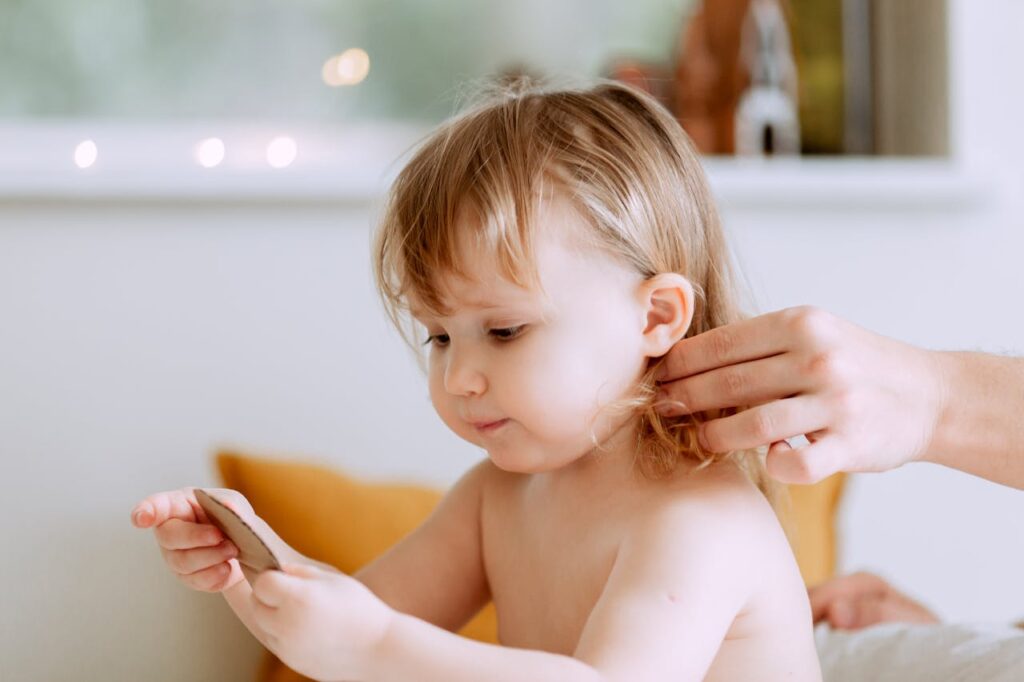There are many hairstyles for newborns, but does your baby need a trim first? Newborns are seen as fragile and vulnerable, which can make certain things a little nerve-racking for new parents. That is a haircut for newborns. The idea of having a sharp tool near your little one can be off-putting. However, there are ways to make this experience pleasant and successful for both the parent and baby. Let’s take a look!
Table of Contents
When to Give a Newborn a Haircut

Deciding on when to cut your newborn’s hair is up to you. Parents wait until there is enough hair. If your little one has a big head of hair, then you may need to start haircuts sooner than you thought. Hair can tickle their ears, or they may be tugging on it. Whatever the reason for the trim, make sure the timing is right.
When the time comes for a haircut, you and your baby should be in the right environment. This means that you need to make sure you are in a comfortable and safe place to give the cut. A fussy baby moves. Make sure that the baby is happy and settled before cutting their hair. This means that the baby has to be well-fed and rested.
Newborn Hair Cutting Tools
Having the right hair tools can make a massive difference in a newborn’s haircut. An old comb and craft scissors just won’t do.

Here are 6 items that you need:
- Baby-friendly scissors to avoid nips and easier to handle
- Baby comb or brush that is the right size
- Soft cloth or towel for their shoulders
- Favorite toys for distraction
- Misting spray bottle with lukewarm water
- Mirror to see different angles and areas
A Calm and Comfortable Environment
Here are 6 steps to help you create a calm environment:
- Choose a quiet room – This can minimize distractions and sudden jumps for you and the baby.
- Soothing music – If silence isn’t a preference or option, then playing gentle and calming music can also help calm nerves.
- A comfortable position – If your newborn can’t keep themselves up, position them in a secure and comfortable spot where you can still access their hair.
- Extra hands – Having another set of hands and eyes can be very helpful. This can help with anxiety. Someone else’s opinion and assistance can make the process run smoothly.
- Keep your tools close – Keep all your haircutting items close by and within reach at all times. This can help minimize accidents or avoid leaving your little one unattended.
- Stay positive. Your baby is very influential on your moods and energy. Make sure you stay calm and regularly reassure them and yourself.
Haircut for Newborn: What to Avoid
1. Being in a rush
It is very important to take your time when cutting a baby’s hair because if you are in a rush or try to do it quickly. This leaves room for potential snips, hair pulls, and an uneven haircut.
2. Using Adult Scissors
It’s best to use scissors designed to cut the baby’s hair. Standard scissors are often too big or dangerous. They can also be difficult to control while cutting around your baby’s small, delicate head.
3. Be in a Busy Environment
Noise is distracting for adults, children, and, of course, babies. Loud noise can make you or your baby jump, resulting in an accident, or you can become highly distracted.
4. Ignoring Your Baby’s State Of Mind
Make sure your baby is happy by paying attention to the mood.
5. Not Taking Any Breaks
Sitting still for a prolonged period can make you and your baby restless. Make sure to take breaks in between to keep them happy.
Baby Hair Care Tips

- Conditioning – Moisturize your baby’s hair. Use natural coconut or almond oils or gentle baby-safe haircare products with moisturizing ingredients.
- Brushing hair regularly – Get your baby used to brushing by incorporating it into their routine. Make sure to use a soft brush that won’t hurt them. Frequent brushing can help with hair growth, a healthy scalp, and tangles.
- Monitor for allergic reactions – When using new hair products, looking out for any potential skin reactions is crucial. These usually appear as a rash, redness, welts, dry, itchy skin, or swelling. Stop using the product immediately and contact your pediatrician.
- Haircare routine – Regular care and trimming, if necessary, ensure that the baby’s hair stays neat and healthy.
FAQs
1. When do babies get their first haircut?
Most parents recommend the first haircut between 6 and 12 months; however, this usually depends on hair growth and personal preference. A good time for a trim is if your baby’s hair is tangling or irritating their eyes.
2. How do I calm my baby down during a haircut?
Be gentle, get rid of unnecessary distractions, play calm music in the background, give them to somebody who can distract them with toys, and ensure they are well-fed and rested. It also helps to keep sessions short and take breaks.
3. How often should I cut my baby’s hair?
If they just got a haircut, wait a few months. You can do their next trim if their hair reaches the same or longer length. It’s all up to you!
Conclusion

Cutting a child’s hair can be daunting, and pressure can worsen nerves. But if the right tools, methods, and tips are used, it can be a fun and successful experience for you both. Trimming your newborn’s hair can be easy if they are happy, well-rested, fed, and calmly distracted. Being patient and taking breaks can be very beneficial. Good luck with your baby’s first haircut, and make sure to take pictures!


